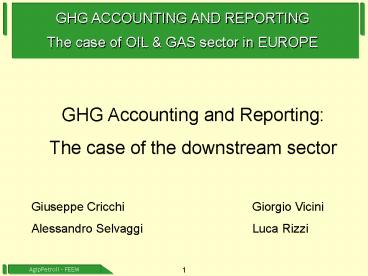GHG - PowerPoint PPT Presentation
1 / 23
Title:
GHG
Description:
The case of the downstream sector. Giuseppe Cricchi Giorgio Vicini ... Process heaters/treaters. IC Engines/turbines. Hydrogen plants. Gas treatment processes ... – PowerPoint PPT presentation
Number of Views:187
Avg rating:3.0/5.0
Title: GHG
1
GHG Accounting and Reporting The case of the
downstream sector Giuseppe Cricchi Giorgio
Vicini Alessandro Selvaggi Luca Rizzi
2
Table of Contents
3
Accounting and reporting guidelines
4
Accounting and reporting guidelines
5
Accounting and reporting guidelines
6
Accounting and reporting guidelines
7
- Reasons for undertaking a verification include
- to add credibility to publicly reported
information - to increase management and board confidence in
reported information - to improve internal GHG accounting and reporting
practices - to meet or anticipate the requirements of future
trading programs.
Accounting and reporting guidelines
8
THE CASE OF A AgipPetroli REFINERY
AgipPetroli Refinery
9
AgipPetroli Refinery
10
ACCOUNT DIRECT GHG EMISSIONS (Scope 1)
A) DIRECT EMISSIONS FROM FUEL COMBUSTION B)
DIRECT EMISSIONS FROM PHYSICAL OR CHEMICAL
PROCESSING C) DIRECT EMISSIONS FROM MOBILE
SOURCES
ACCOUNT INDIRECT GHG EMISSIONS (Scope 2)
A) INDIRECT EMISSIONS FROM ELECTRICITY/STEAM
PURCHASE
ACCOUNT OTHER INDIRECT GHG EMISSIONS (Scope 3)
AgipPetroli Refinery
11
AgipPetroli reports on GHG (mainly CO2) emissions
data - data of the reporting year - data of the
previous four years in order to compare its
environmental performance improvement
AgipPetroli Refinery
12
IDENTIFYING GHG SOURCES OF EMISSIONS
X
//
Catalytic reforming
X
Asphalt production
//
Sulphur recovery units
X
//
//
Mobile Sources (transport)
Direct venting
//
//
Gas treatment processes
Furnace tube decoking
//
//
Catalytic cracker regenerators
X
X gt High Impact sources
// gt low impact sources
AgipPetroli Refinery
13
IDENTIFYING SOURCES OF CO2 EMISSIONS
Catalytic reforming
Gas treatment processes
Furnace tube decoking
Sulphur recovery units
Asphalt production
Mobile Sources (transport)
Boilers
Process heaters/treaters
IC Engines/turbines
Hydrogen plants
Catalytic cracker regenerators
AgipPetroli Refinery
14
IDENTIFYING SOURCES OF CO2 EMISSIONS
- AgipPetroli Refinery case study
- GHGs are mainly CO2 emissions
- Methane (CH4) and nitrous oxide (N2O)
contributes for a no significant rate - No other GHG emissions
AgipPetroli Refinery
15
ACCOUNT DIRECT GHG EMISSIONS (Scope 1)
A) DIRECT EMISSIONS FROM FUEL COMBUSTION
AgipPetroli Refinery
16
ACCOUNT DIRECT GHG EMISSIONS (Scope 1)
A) DIRECT EMISSIONS FROM FUEL COMBUSTION
CONCAWE conversion factors to calculate GHG
emissions due to stationary combustion The BREF
work on BAT is based on CONCAWE analysis
AgipPetroli Refinery
17
ACCOUNT DIRECT GHG EMISSIONS (Scope 1)
B) DIRECT EMISSIONS FROM MOBILE SOURCES
AgipPetroli Refinery
18
ACCOUNT INDIRECT GHG EMISSIONS (Scope 2)
A) INDIRECT EMISSIONS FROM ELECTRICITY/STEAM
PURCHASE
NATIONAL AVERAGE EMISSION FACTOR
AgipPetroli Refinery
19
AgipPetroli Refinery
20
AgipPetroli Refinery
21
1. Define clear organisational and operational
boundaries 2. Apply and compare IEA and IPCC
international conversion factors 3. Account and
Report GHGs emissions from marginal sources 4.
Identify GHG emissions from indirect source, i.e.
drilling and transport of oil (upstream),
production of input used in the oil cycle
refinery, oil products use and re-use, waste
management and recycling.
Future steps
22
1. There is no such thing as a universal oil
refinery they differ in size, complexity, types
of processes they operate, the crudes they
process 2. Climatic/environmental conditions and
the location can influence impact of emissions on
the environment 3. It could be necessary a site
specific content to account these differences.
Future steps
23
CONCLUSIONS
1. The oil refinery sector requests the
definition and development of a corporate
international and standardized methodology for
GHG accounting 2. AgipPetroli is willing to
cooperate with other companies and institutions
involved in identifying and supporting a national
and international methodology
Conclusions































